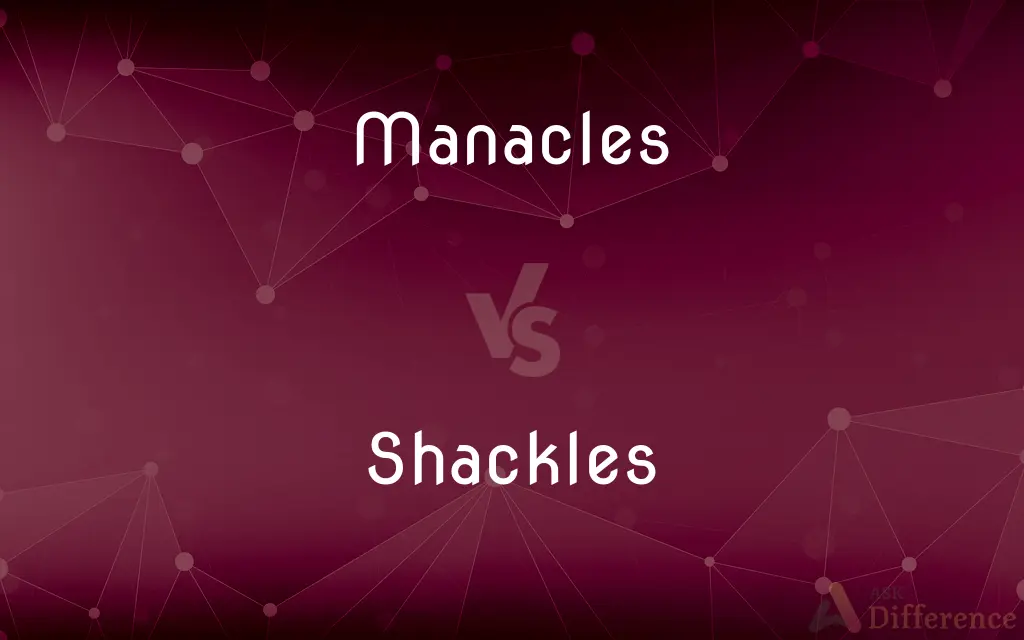Manacles vs. Shackles — What's the Difference?
Edited by Tayyaba Rehman — By Fiza Rafique — Updated on April 8, 2024
Manacles are restraining devices typically used on the wrists or hands, while shackles are similar restraints used on the ankles or feet.

Difference Between Manacles and Shackles
Table of Contents
ADVERTISEMENT
Key Differences
Manacles are designed specifically for the wrists or hands to restrict arm movements, commonly used in law enforcement and historical imprisonment contexts. They can be made from various materials, including metal, and often consist of two cuffs connected by a chain or bar. On the other hand, shackles are used to bind the ankles or feet, limiting leg movement and making walking difficult or slow. Like manacles, shackles can be made of metal and feature a locking mechanism.
The primary purpose of both manacles and shackles is to impede mobility and prevent escape. Manacles focus on restricting the use of hands, making it difficult for an individual to perform tasks or use force effectively. Shackles, by restricting the feet, primarily limit an individual's ability to walk or run. While both are forms of physical restraint, the choice between manacles and shackles or the use of both depends on the specific need to limit hand or foot movement.
In historical contexts, manacles and shackles were often used together to severely restrict prisoners' movements. Today, these restraints are subject to strict legal and ethical guidelines regarding their use. Manacles, given their restriction on hand movements, are commonly used in situations requiring the secure transport of a detainee. Shackles, with their focus on limiting leg mobility, may be used in circumstances where there is a higher risk of escape or when transporting prisoners over longer distances.
The terms "manacles" and "shackles" can also be used metaphorically to describe constraints or limitations on freedom and ability. In literature and speech, manacles might symbolize constraints on actions or capabilities, whereas shackles might represent limitations on progress or movement more broadly.
Comparison Chart
Usage
Restrict movements of hands/wrists
Restrict movements of ankles/feet
ADVERTISEMENT
Purpose
Prevent use of hands, ensure detainee control
Limit walking/running, prevent escape
Material
Often metal, with cuffs and connecting chain/bar
Often metal, with cuffs and connecting chain
Application
Law enforcement, historical imprisonment
Law enforcement, historical imprisonment, transportation
Symbolism
Constraints on actions or capabilities
Limitations on progress or freedom
Compare with Definitions
Manacles
Wrist cuffs.
The magician escaped from the manacles as part of his act.
Shackles
Foot restraints.
The guard removed the shackles from the prisoner's ankles before entering the cell.
Manacles
Restrictive devices.
The historical exhibit displayed manacles used in the 19th century.
Shackles
Limitation devices.
The heavy shackles made it impossible for him to run.
Manacles
Detainment tools.
Police officers carry manacles as part of their standard equipment.
Shackles
Symbol of restraint.
He described his addiction as shackles that he struggled to break free from.
Manacles
Hand restraints.
The prisoner was led into the courtroom with manacles around his wrists.
Shackles
Mobility restrictors.
The fugitive was caught and placed in shackles before being transported back to jail.
Manacles
Symbol of oppression.
In his speech, he referred to poverty as the manacles holding society back.
Shackles
Ankle cuffs.
Shackles were commonly used during the transport of convicts in the past.
Manacles
A device for confining the hands, usually consisting of a set of two metal rings that are fastened about the wrists and joined by a metal chain.
Shackles
A device, usually one of a pair connected to a chain, that encircles the ankle or wrist of a prisoner or captive.
Manacles
Something that confines or restrains
"caught in the manacles of their language" (Cynthia Ozick).
Shackles
A hobble for an animal.
Manacles
To put manacles on (someone); restrain with manacles.
Shackles
Any of several devices, such as a clevis, used to fasten or couple.
Manacles
To restrain the action or progress of
"[She was] manacled by the restrictions of an overbearing father" (Lilian Faderman).
Shackles
Often shackles A restraint or check on action or progress
"throwing off the puritanical shackles" (Ben Yagoda).
Manacles
Plural of manacle
Shackles
To put shackles on (someone); confine with shackles.
Manacles
Manacle
Shackles
To fasten or connect with a shackle.
Shackles
To restrict, confine, or hamper.
Shackles
Plural of shackle
Common Curiosities
What is the main difference between manacles and shackles?
Manacles are designed for wrists or hands, while shackles are intended for ankles or feet.
Are there ethical concerns with using manacles and shackles?
There are significant ethical and legal guidelines governing the use of such restraints to prevent abuse.
How have manacles and shackles evolved over time?
Both have evolved from simple metal restraints to include safety features and standards to prevent injury.
Do manacles and shackles have uses outside of imprisonment?
They are used in law enforcement, security, and even entertainment (e.g., magic shows), but always with considerations for safety and consent.
What materials are manacles and shackles made from?
Historically, iron or steel, but modern versions may use lighter or coated materials for safety and comfort.
How do manacles and shackles work?
Both use a locking mechanism to secure the cuffs around the wrists or ankles, limiting movement.
What role do manacles and shackles play in historical punishment?
They were commonly used as punishment devices, symbolizing control and suppression.
How is the safety of detainees ensured when using these restraints?
By following legal guidelines, using restraints properly, and ensuring they do not cause unnecessary harm.
Can manacles and shackles be used together?
Yes, they are often used together to maximally restrict a detainee's mobility.
Are there alternative restraint devices to manacles and shackles?
Yes, there are various restraint devices designed for specific situations, including plastic zip ties and specialized belts.
Can manacles and shackles be legally used today?
Their use is regulated by law and typically restricted to law enforcement and corrections with strict guidelines.
What symbolism do manacles and shackles carry in literature?
They often symbolize oppression, lack of freedom, or the burden of constraints.
Are there specific laws governing the use of manacles and shackles?
Yes, there are specific laws and international guidelines to prevent their misuse and abuse.
How do manacles and shackles impact the movement of an individual?
Manacles restrict hand use, while shackles limit leg movement, affecting walking and running.
What considerations should be taken when applying manacles and shackles?
Considerations include the individual's rights, the necessity of restraint, and the potential for injury.
Share Your Discovery

Previous Comparison
Goddess vs. Woman
Next Comparison
Shrink vs. ShrivelAuthor Spotlight
Written by
Fiza RafiqueFiza Rafique is a skilled content writer at AskDifference.com, where she meticulously refines and enhances written pieces. Drawing from her vast editorial expertise, Fiza ensures clarity, accuracy, and precision in every article. Passionate about language, she continually seeks to elevate the quality of content for readers worldwide.
Edited by
Tayyaba RehmanTayyaba Rehman is a distinguished writer, currently serving as a primary contributor to askdifference.com. As a researcher in semantics and etymology, Tayyaba's passion for the complexity of languages and their distinctions has found a perfect home on the platform. Tayyaba delves into the intricacies of language, distinguishing between commonly confused words and phrases, thereby providing clarity for readers worldwide.
















































